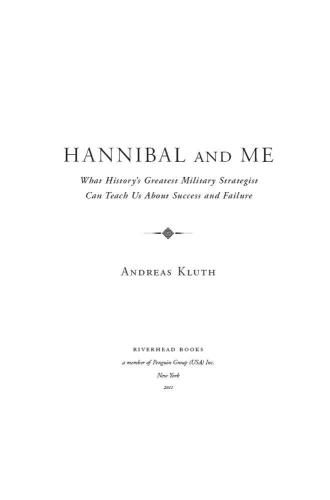
Hannibal and Me
What History's Greatest Military Strategist Can Teach Us About Success andFailure
کتاب های مرتبط
- اطلاعات
- نقد و بررسی
- دیدگاه کاربران
نقد و بررسی

October 3, 2011
Several books on the legendary achievements of Hannibal have dwelled on one or two aspects of the ingenious general’s life, but none has tackled the tricky mix of the impact of his life choices on and off the battlefield as well as this new analysis. Kluth, the West Coast correspondent for the Economist, brings a contemporary slant to Hannibal’s military successes. Outnumbered by Roman legions, Hannibal couldn’t win with brute force alone, but needed shrewd strategies and tactics. Bred to be a great soldier, Hannibal took the helm at age 26 in Carthage, then famously crossed the Alps to defeat one Roman army after another. For students of history or military tactics, Kluth does superior work in spelling out the elusive values of success and failure,: he explains how, like Hannibal, you can make your enemies defeat themselves; he also considers others like Fabius, who kept Hannibal on edge by attacking wherever Hannibal’s troops were not; and Kluth fast-forwards to today’s world, showing how Steve Jobs, like the ancients, learned to turn disaster into triumph. Realistic and timely, Kluth’s book uses historic truths to move us past the frequent traps of success and failure to mold practical, productive lives.

November 1, 2011
Economist writer Kluth takes lessons from the great military strategist and other historical titans in his quest for fulfillment beyond success. In 218 BCE, Hannibal and his army surprised the Romans by crossing the Alps to attack Italy by land. The author narrates Hannibal's story with precision, but his analysis extends beyond the highlights of the battlefield. In this retelling of the ancient drama, the major players become archetypes whose motivations, triumphs and failures mirror those of more recent historical figures. The influence of Carl Jung pervades as the narrative as Kluth digs into their psyches—examples include author Amy Tan's teenage rebellion, Eleanor Roosevelt's loneliness and Albert Einstein's dark side—to create a plausible formula for surviving disaster or even sudden, explosive success. Though brief, the contemporary examples bridge the gap between modern readers and the ancient world. Kluth's own connection to Hannibal is tenuous, explained with a brief recap of how he took off his expensive tie and left London's Wall Street to become a journalist. But his desire for a balanced life (and European disdain for ostentation) makes his voice unique among others who analyze the nuances of greatness. Kluth follows each character beyond the key moments that defined their places in history to determine the value of their lives as a whole, from the rise and fall of their careers to their evolving relationships with families and friends. The result is a study of the ephemeral nature of power that grapples, often very effectively, with the meaning of true happiness. Meatier than the average self-help book, Hannibal and Me is a rare blend of military strategy and emotional intelligence that offers a more mature solution for winning life's battles.
(COPYRIGHT (2011) KIRKUS REVIEWS/NIELSEN BUSINESS MEDIA, INC. ALL RIGHTS RESERVED.)

February 1, 2012
War and military metaphors are popular in business titles, but Kluth's (West Coast correspondent, The Economist) book delves further into historical detail than most. Detailing the life of Carthaginian general Hannibal, best known for marching his army (plus elephants) over the Alps to surprise his archenemy Rome, Kluth explores how the singular soldier and tactician experienced both success (he won all his battles save the last) and failure (he was driven from Italy, and Rome eventually burned Carthage to the ground). The book teases life lessons out of both Hannibal's story and stories of other singular individuals: Eleanor Roosevelt, for example, reinvented herself after the devastating experience of discovering her husband's infidelity; Kluth's own great-uncle, Ludwig Erhard, eschewed political party membership but still became chancellor of West Germany. While following Hannibal's life chronologically, Kluth quietly makes suggestions for readers of all ages: understand your early influences, recognize triumph and failure as mere steps on the journey, and keep your ideas fresh. VERDICT Business readers will likely find this how-to a surprisingly satisfying read for both its history lessons and its basic but enduring dicta.--Sarah Statz Cords, The Reader's Advisor Online
Copyright 2012 Library Journal, LLC Used with permission.

December 15, 2011
Here's an intriguing premise: show, through the life and career of the Carthaginian military genius Hannibal (and other history-makers), how the line between success and failure can sometimes be blurry, not to mention how success can turn into failure when least expected, and vice versa. Always outnumbered, Hannibal planned meticulously and never lost a war against Rome in 16 years of battle. On the other hand, he never conquered Rome. So was his career triumph or tragedy? How about General MacArthur, whose surprise landing at Inchon, South Korea, led to immediate triumph and, later, embarrassing failure? Kluth's main thesis seems to be that triumph and tragedy, success and failure, are merely points on a line, and that we make our way in life by cultivating the ability to turn failure into success and recognizing that success can breed failure, if we're not careful. This isn't the first book to tackle this subject, but its historical perspective, drawing on the life of a warrior who lived more than two millennia ago, gives it fresh appeal.(Reprinted with permission of Booklist, copyright 2011, American Library Association.)

























دیدگاه کاربران